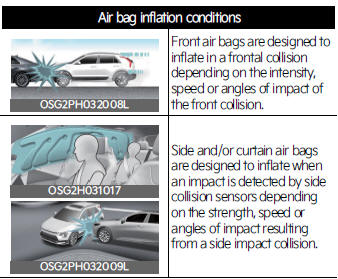KIA Niro: Air bag collision sensors

* The actual features in your vehicle may not necessarily be available due to the selected options or regions.
- Supplemental Restraint System (SRS) control module/rollover sensor
- Front impact sensor
- Side pressure sensors (front door)
- Side impact sensor (B-pillar)
WARNING
- Do not hit or allow any objects to
impact the locations where air bag or
sensors are installed.
This may cause unexpected air bag deployment, which could result in serious personal injury or death.
- If the installation location or angle of
the sensors is altered in any way, the
air bags may deploy when they
should not or they may not deploy
when they should, causing severe
injury or death.
Therefore, do not try to perform maintenance on or around the air bag sensors.
Have the system serviced by a professional workshop. Kia recommends visiting an authorized Kia dealer/service partner.
- Problems may arise if the sensor installation angles are changed due to the deformation of the front bumper, body or B pillar where side collision sensors are installed. In this case, have the system serviced by a professional workshop. Kia recommends to visit an authorized Kia dealer/service partner.
- Your vehicle has been designed to
absorb impact and deploy the air
bag(s) in certain collisions.
Use only Kia Genuine Parts or those of an equivalent standard to install bumper guards or replace a bumper.
If not, it may adversely affect your vehicle's collision and air bag deployment performance.
- If equipped with rollover sensor If your vehicle is equipped with side and curtain air bag, press EV button to OFF position and wait for 3 minutes when the vehicle is being towed.
The side and curtain air bag may deploy when the EV button is in ON or OFF position within 3 minutes, and the rollover sensor detects the situation as a rollover.
Air bag inflation conditions

INFORMATION
Side and curtain air bags (if equipped)
Also, the side and curtain air bags are designed to inflate when a rollover is detected by a rollover sensor.
Although the front air bags (driver's and front passenger's air bags) are designed to inflate only in frontal collisions, they also may inflate in other types of collisions if the front impact sensors detect a sufficient impact. Side air bags (side and/or curtain air bags) are designed to inflate only in side impact collisions, but they may inflate in other collisions if the side impact sensors detect a sufficient impact.
For instance, side airbag and curtain air bags may inflate if rollover sensors indicate the possibility of a rollover occurring (even if none actually occurs) or in other situations, including when the vehicle is tilted while being towed. Even if side and/or curtain air bags do not provide impact protection in a rollover, they will deploy to prevent ejection of occupants, especially those who are restrained with seat belts.
If the vehicle chassis is impacted by bumps or objects on unimproved roads or sidewalks, air bags may deploy. Drive carefully on unimproved roads or on surfaces not designed for vehicle traffic to prevent unintended air bag deployment.
NOTICE
If equipped with rollover sensor
Also, the side and curtain air bags are designed to inflate when a rollover is detected by a rollover sensor.
READ NEXT:
 Air bag non-inflation conditions
Air bag non-inflation conditions
WARNING
The SRS is designed to deploy the
front air bags only when an impact is
sufficiently severe and when the
impact angle is less than 30º from the
forward longitudinal axis of the vehicle.
Front air bags are not intended t
 Additional safety precautions
Additional safety precautions
Never let passengers ride in the
cargo area or on top of a foldeddown
back seat. All occupants
should sit upright, fully back in their
seats with their seat belts on and their
feet on the floor.
Passengers should not move out of
or c
 Air bag warning labels
Air bag warning labels
Left-hand drive
Right-hand drive
Air bag warning label (Type A)
Air bag warning label (Type B)
Air bag warning labels are attached to
alert the passengers of potential risk of
air bag system.
Note that these government warnin
SEE MORE:
 Heater Unit Repair procedures
Heater Unit Repair procedures
Replacement
Warning
When prying with a flat-tip screwdriver or a prying trim tool, wrap
a protective tape around the related parts and the tool to
prevent damage.
Disconnect the negative (-) battery terminal.
Recover the refrigerant with a
 Rear Seat Cushion Cover | Rear Back Armrest
Rear Seat Cushion Cover | Rear Back Armrest
Rear seat cushion cover
Replacement
Remove the seat assembly.
(Refer to Rear Seat - "Rear Seat Assembly")
Remove the rear seat cushion cover (A) after removing the hog-ring clips on the rear of seat cushi
Categories
- Home
- KIA Niro EV, Hybrid - Second generation - (SG2) (2021-2024) - Owner's manual
- Kia Niro - First generation - (DE) (2017-2022) - Service and Repair Manual
- Contact Us
